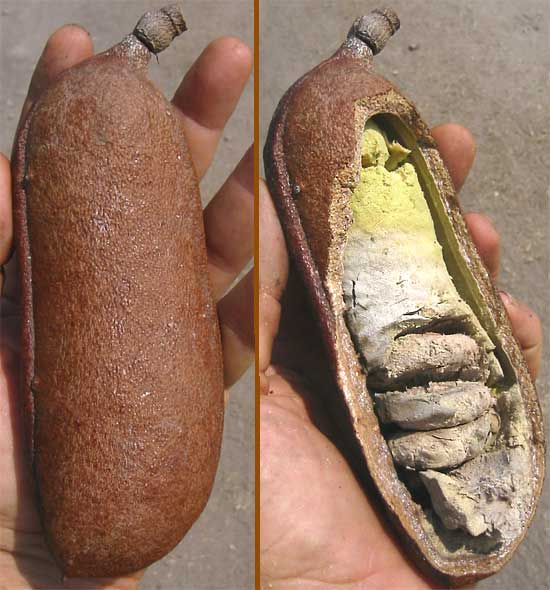Excerpt from Jim Conrad's
Naturalist Newsletter
from the May 12, 2008 Newsletter, written in the community of 28 de Junio and issued from a ciber 10 kms to the west in
Venustiano Carranza, Chiapas, MÉXICO
GUAPINOLE'S BIG BEAN POD
Don Andrés brought me the humongous bean pod shown below:

By referring to it as a bean pod I mean to say that the plant producing it is a member of the Bean Family, the Fabaceae. The plant is a tree known around here as Bacú but in much of Mexico as Guapinol or Huapinol. In Latin it's HYMENAEA COURBARIL, a name given by Linnaeus himself, so America's first botanical explorers must have noticed this tree early.
Don Andrés told me that inside the six-inch-long pod (15 cm) big beans were suspended in a kind of dryish powder, and that that powder made good eating. The pod's woody shell was so hard I couldn't crack it with the handle of my Buck Knife. When the pod finally broke I was disappointed to see that most of its contents were moldy and inedible. In the picture, the white, lower part of the contents is fungusy but the yellow, upper part is still at least marginally edible. It tasted like sweet, custard-flavored chalk. Maybe a fresher pod wouldn't have been so powdery.
Holding the broken pod in my hand while taking the picture, the pod's fracture surfaces glistened in the sunlight as if crushed glass were embedded in the brown shell matrix. My hand lens revealed the source of the glistens: hardened globules of resin.
I'm not the first to notice this tree's resin. Las Plantas Medicinales de Mexcio says that resin from Guapinol can be burned to produce a smoke which, inhaled, alleviates asthma. It's also used against rheumatism, colds, ulcers and other ailments.